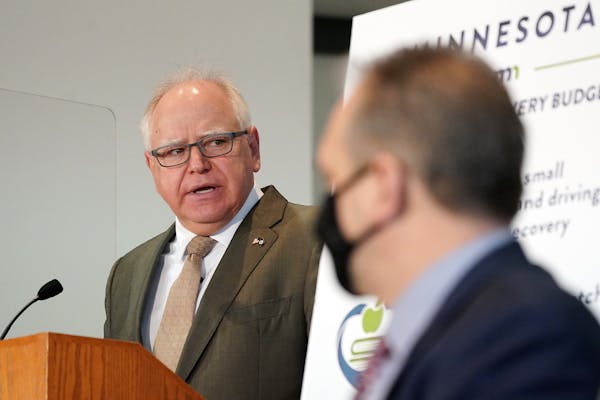Minnesota's budget surplus has ballooned to a historic $17.6 billion amid lower spending and larger tax collections, triggering a flood of ideas for how to spend the extra cash.
A funding boost for classrooms, climate change investments and potential tax relief are all on the table for Democrats, who will control state government when the Legislature convenes in January.
"We can do all of these things. This isn't a choice of either-or," DFL Gov. Tim Walz said after the new economic forecast was released Tuesday. "There's golden opportunities for us to do things on so many fronts."
The forecast, nearly double the projected surplus of over $9 billion in February, kicks off the process of setting the state's more than $50 billion two-year budget. Flush with resources, Democrats must contend with pent-up demand from allied groups after years of divided government in Minnesota. Top leaders also signaled some potential disagreements about revived proposals from Walz to cut taxes on Social Security income and give Minnesotans direct rebate checks.
But everyone could agree on one thing: There's plenty of money to go around.
"That's an incredible balance, any way you look at it," Minnesota Management and Budget Commissioner Jim Schowalter said. "The governor and the lawmakers have more options than they have usually had to invest in Minnesota and address the needs of Minnesota's families, businesses and communities."
Since Minnesota's last forecast in February, the state continued to collect more than projected in taxes, particularly income and corporate taxes. On the spending side, costs for expensive state programs such as health care and education decreased because of an influx of federal COVID-19 aid and lower-than-anticipated K-12 public school enrollment.
But a large part of the surplus is money that was left on the table last session, when lawmakers failed to finalize a sweeping multibillion-dollar package of tax cuts and funding for classrooms, health care and public safety initiatives. The stalemate meant $7 billion was rolled over into the current projected surplus.
Walz revived some of his previous spending priorities during a Tuesday news conference, saying he will again push for returning a share of the money to taxpayers in the form of direct rebate checks. He said he will propose $1,000 for individuals and $2,000 for families as a starting point.
The governor said the state should cut taxes on Social Security income and boost funding for schools, public safety, child care, infrastructure and climate change initiatives.
"Minnesota is going to be a leader in addressing climate change and the creation of green jobs," Walz said.
Legislative Democrats, who kept control of the Minnesota House and narrowly took power in the state Senate in the midterm election, have signaled a desire to spend some of the surplus on setting up a statewide paid family and medical leave program in Minnesota.
Senate Majority Leader Kari Dziedzic and House Majority Leader Jamie Long, both Democrats from Minneapolis, listed investments in affordable housing, child care and climate change among their top priorities.
During a joint news conference, Dziedzic and Long were lukewarm about Walz's call for direct rebate checks but indicated their caucuses will consider the proposal. The two legislative leaders were more skeptical of cutting taxes on Social Security income, citing concerns about the effect on the budget.
"I'm on the record for having deep concerns about that," Dziedzic said.
The surplus could grow or shrink by the February economic forecast, which will kick off the Legislature's budget work.
Republicans, who will be in the minority in both chambers next session, said the massive surplus means Minnesotans are being overtaxed and warned against overreach by Democrats.
"That money needs to go back to Minnesotans," said House Minority Leader Lisa Demuth, R-Cold Spring. "Tax hikes should be completely off the table."
Demuth said she's open to Walz's rebate check proposal and wants to end state taxes on Social Security benefits. She said she hopes to work together with Democrats on issues such as affordable housing and child care.
With inflation and energy costs still high — plus a possible recession looming — Senate Minority Leader Mark Johnson, R-East Grand Forks, said Minnesotans need ongoing relief.
"The last time Democrats had single-party control, we saw a plethora of new government programs requiring billions in permanent tax and fee increases," he said in a statement. "We simply can't afford to see government grow faster than our paychecks."
Senate Republicans will likely have some say in the budgeting process because Democrats hold a one-seat majority in the chamber. The minority party will also play a part in crafting a public works borrowing package, which Democrats said was a priority after negotiations fell apart last spring. Bonding bills require a three-fifths majority for passage.
Schowalter described Minnesota's economic outlook as "stable and resilient," with one of the lowest unemployment rates in the country and revenues expected to exceed spending over the next several years.
A more than $8 billion surplus is projected in the 2026-2027 state budget, and Minnesota's budget reserves now sit at a record $2.8 billion. But budget officials said a "mild, three-quarter recession" is expected to begin now — in the fourth quarter of 2022 — and high inflation is not factored into the state's spending estimates.
Schowalter said inflation would reduce the surplus by $1.5 billion. Some groups are pushing to restore calculations about inflation in state budget forecasts.
"Eighteen billion dollars sounds like a tremendously large balance, it does," Schowalter said. "Yet, we know there's plenty of families, plenty of industries, plenty of needs out there because inflation has eaten away some of the ability to run programs that help people with the last couple of years."
Former DFL Senate Majority Leader Kari Dziedzic dies of cancer at age 62

How the Star Tribune is covering the 2024 election

Fact check: Walz and Vance made questionable claims during only VP debate

In Tim Walz's home city, opposing groups watch him debate on the national stage



